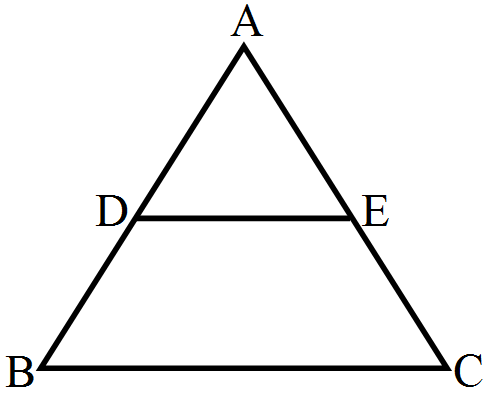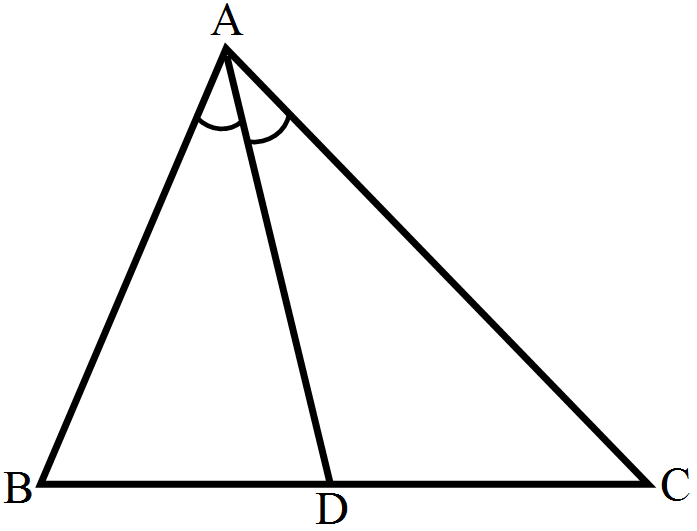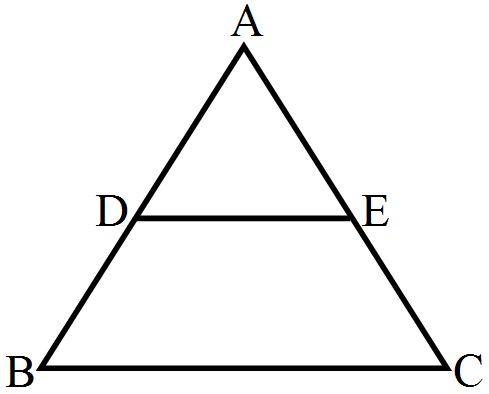D and E are points on the sides AB and AC respectively of a $\triangle\text{ABC}.$ In the following cases, determine whether DE || BC or not.
AB = 10.8cm, AD = 6.3cm, AC = 9.6cm and EC = 4cm.

AB = 10.8cm, AD = 6.3cm, AC = 9.6cm and EC = 4cm.

We have:
AB = 10.8cm, AD = 6.3cm
Therefore,
DB = 10.8 - 6.3 = 4.5cm
Similarly,
AC = 9.6cm, EC = 4cm
Therefore,
AE = 9.6 - 4 = 5.6cm
Now,
$\frac{\text{AD}}{\text{DB}}=\frac{6.3}{4.5}=\frac{7}{5}$
$\frac{\text{AE}}{\text{EC}}=\frac{5.6}{4}=\frac{7}{5}$
$\Rightarrow\frac{\text{AD}}{\text{DB}}=\frac{\text{AE}}{\text{EC}}$
Applying the converse of Thalse' theorem, we conclude thet DE || BC.
AB = 10.8cm, AD = 6.3cm
Therefore,
DB = 10.8 - 6.3 = 4.5cm
Similarly,
AC = 9.6cm, EC = 4cm
Therefore,
AE = 9.6 - 4 = 5.6cm
Now,
$\frac{\text{AD}}{\text{DB}}=\frac{6.3}{4.5}=\frac{7}{5}$
$\frac{\text{AE}}{\text{EC}}=\frac{5.6}{4}=\frac{7}{5}$
$\Rightarrow\frac{\text{AD}}{\text{DB}}=\frac{\text{AE}}{\text{EC}}$
Applying the converse of Thalse' theorem, we conclude thet DE || BC.
Download our appand get started for free
Experience the future of education. Simply download our apps or reach out to us for more information. Let's shape the future of learning together!No signup needed.*
Similar Questions
- 1The corresponding sides of two similar triangles ABC and DEF are BC = 9.1cm and EF = 6.5cm. If the rerimeter of $\triangle\text{DEF}$ is 25cm, find the perimeter of $\triangle\text{ABC}.$View Solution
- 2View SolutionFor the following statments state whether true (T) or false(F):
Any two rectangles are similar. - 3View SolutionFor the following statments state whether true (T) or false(F):
The ratio of the areas of two similar triangles is equal to the ratio of their corresponding angle-bisector segments. - 4In a $\triangle\text{ABC},\text{AD}$ is the bisector of $\angle\text{A}.$ If AB = 5.6cm, BD = 3.2cm and BC = 6cm, find AC.View Solution

- 5D and E are points on the sides AB and AC respectively of a $\triangle\text{ABC}.$ In the following cases, determine whether DE || BC or not.View Solution
AD = 5.7cm, DB = 9.5cm, AE = 4.8cm and EC = 8cm.

- 6In the given figure, D is the midpoint of side BC and $\text{AE}\perp\text{BC}.$ If BC = a, AC = b, AB = c, ED = x, AD = p and AE = h, prove that.View Solution

$(\text{b}^2-\text{c}^2)=2\text{ax}$ - 7View SolutionThe sides of certain triangles are given below. Determine them are right triangles:
1.4cm, 4.8cm, 5cm. - 8View SolutionA 13-m-long ladder reaches a window of a building 12m above the ground. Determine the distance of the foot of the ladder from the building.
- 9If the lengths of the sides BC, CA and AB of a $\triangle\text{ABC}$ are a, b and c respectively and AD is the bisectore of $\angle\text{A}$ then find the lengths of BD and DC.View Solution
- 10View SolutionProve that the ratio of the perimeters of two similar triangles is the same as the ratio of their corresponding sides.
